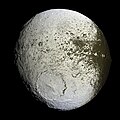File:Iapetus as seen by the Cassini probe - 20071008.jpg

Dimensioni di questa anteprima: 600 × 600 pixel. Altre risoluzioni: 240 × 240 pixel | 480 × 480 pixel | 768 × 768 pixel | 1 024 × 1 024 pixel | 2 048 × 2 048 pixel | 4 032 × 4 032 pixel.
File originale (4 032 × 4 032 pixel, dimensione del file: 6,22 MB, tipo MIME: image/jpeg)
Cronologia del file
Fare clic su un gruppo data/ora per vedere il file come si presentava nel momento indicato.
| Data/Ora | Miniatura | Dimensioni | Utente | Commento | |
|---|---|---|---|---|---|
| attuale | 19:07, 12 dic 2018 |  | 4 032 × 4 032 (6,22 MB) | Kesäperuna | 100% JPEG quality from full quality TIFF, slightly cropped to be more centered. |
| 10:18, 9 ott 2007 |  | 4 100 × 4 100 (1,56 MB) | Startaq | {{Information |Description = Cassini captures the first high-resolution glimpse of the bright trailing hemisphere of Saturn's moon Iapetus. This false-color mosaic shows the entire hemisphere of Iapetus (1,468 kilometers, or 912 miles across) visible fro |
Pagine che usano questo file
Le seguenti 6 pagine usano questo file:
Utilizzo globale del file
Anche i seguenti wiki usano questo file:
- Usato nelle seguenti pagine di af.wiki.x.io:
- Usato nelle seguenti pagine di an.wiki.x.io:
- Usato nelle seguenti pagine di ar.wiki.x.io:
- Usato nelle seguenti pagine di ary.wiki.x.io:
- Usato nelle seguenti pagine di arz.wiki.x.io:
- Usato nelle seguenti pagine di ast.wiki.x.io:
- Usato nelle seguenti pagine di az.wiki.x.io:
- Usato nelle seguenti pagine di ba.wiki.x.io:
- Usato nelle seguenti pagine di be.wiki.x.io:
- Usato nelle seguenti pagine di bg.wiki.x.io:
- Usato nelle seguenti pagine di bn.wiki.x.io:
- Usato nelle seguenti pagine di bn.wikibooks.org:
- Usato nelle seguenti pagine di bs.wiki.x.io:
- Usato nelle seguenti pagine di ca.wiki.x.io:
- Usato nelle seguenti pagine di ckb.wiki.x.io:
- Usato nelle seguenti pagine di cs.wiki.x.io:
- Usato nelle seguenti pagine di cv.wiki.x.io:
- Usato nelle seguenti pagine di cy.wiki.x.io:
- Usato nelle seguenti pagine di de.wiki.x.io:
Visualizza l'utilizzo globale di questo file.




